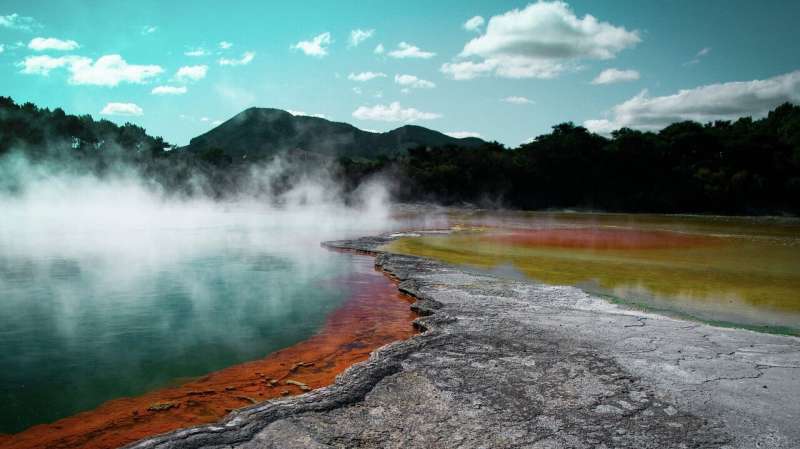Credit: CC0 Public Domain
The use of dirty coal as a heat source makes life tough in the Mongolian winter. ETH geophysicists are helping to develop geothermal energy as a clean alternative.
Many Europeans have an idyllic view of Mongolia as a land of wide, empty spaces and pristine nature. But the truth is more complicated, especially in winter. That's the time of year when life is anything but idyllic for the people who live here. Their settlements are shrouded in thick, sooty smoke that makes it difficult to breathe. The inhabitants face levels of pollution that are up to 80 times higher than guideline values specified by the World Health Organization (WHO) – an unacceptable situation given that the dirty air causes severe health problems among local residents.
Underground potential
One way out of this dilemma would be to stop heating houses with antiquated coal stoves that release unfiltered smoke, switching instead to renewable, clean energy sources. Mongolia offers many of the right conditions to achieve this, largely thanks to the hot magma hidden beneath the country's surface. Numerous hot springs—some reaching temperatures as high as 87 degrees Celsius—signal the presence of this natural resource. Mongolia already makes use of geothermal energy for various purposes, including heating greenhouses. However, any larger-scale use of this energy source would require far more water than currently reaches the surface. The problem is that the hot water only flows along certain subterranean strata—and without knowing where they are, any attempt to drill down into these valuable geothermal reservoirs is ultimately something of a gamble.
This is an experience familiar to many local people in Tsetserleg, the capital of Arkhangai Province in central Mongolia. The water brought to the surface by previous drilling projects has been barely hotter than 40 degrees Celsius. That might be acceptable for a hot bath, but it's not enough to heat a whole city, let alone generate electricity. Local authorities were therefore sceptical when ETH researchers suggested they should make a new attempt to exploit the region's geothermal energy resources on a large scale.
But Martin Saar, Professor of Geothermal Energy and Geofluids in the Department of Earth Sciences, and Friedemann Samrock, Senior Assistant in Saar's group, are confident the city could be heated with geothermal energy. "The conditions in Tsetserleg are ideal, with hot water underground, plus an existing district heating system to distribute the heat," says Saar. The system is currently powered by energy from coal firing, but it would be relatively easy to operate it using hot water from beneath the Earth's surface.
Fields and fluctuations
Saar and Samrock have good reason for feeling confident that they can find the right spots to access these reservoirs of hot groundwater. Their plan is to make use of magnetotellurics, a geophysical measurement method that can be used to infer exactly where subsurface water-bearing strata are located. This method is based on the fact that temporal variations in the Earth's magnetic field induce eddy currents in electrically conductive structures beneath the Earth's surface. Fluctuations in the Earth's magnetic field can be caused by phenomena such as solar wind and global lightning activity. The naturally occurring electrical field induced by these fluctuations produces a secondary magnetic field that—with the right measuring equipment—can be measured and analysed at the Earth's surface. "The measured data reveals the variations in electrical conductivity of subsurface materials. And since the conductivity of water-bearing strata is different to that of the dry rock around them, this analysis tells us where we can find hot water," says Samrock.
One of the advantages of Mongolia is that there is less electrical noise from human activity than in heavily populated countries such as Switzerland. This aided the speedy conclusion of the first measurement campaign last summer. The researchers were able to set up their measuring equipment to detect subsurface structures at a total of 184 different sites. "We're now in the process of analysing the data," says Samrock. "Next summer we intend to run a second measurement campaign to take a more in-depth look at the sites we feel are particularly promising."
The ETH geophysicists have another trump card to play when it comes to analysing the data, namely their collaboration with the Earth and Planetary Magnetism group, which has spent several years conducting research in Mongolia. The group has developed sophisticated numerical methods for analysing subsurface structures. "Our colleagues' computational programme has two key strengths. It takes into account the topography of the Earth's surface—unlike other programmes that simply assume it to be flat—and it correctly models the variations in resolution caused by the uneven distribution of the measuring stations," says Samrock.
Research for development
Yet this project is not only about geophysical research, but also about transferring knowledge. That's because it forms part of the Swiss Programme for Research on Global Issues for Development, which means it receives joint funding from the Swiss National Science Foundation and the Swiss Agency for Development and Cooperation SDC. It also includes the participation of the Mongolian Academy of Sciences. "One of our team members is an ETH doctoral student in my group, originally from Mongolia, who will continue working there once he graduates as an expert in this field," says Saar. "We will also be leaving our equipment in Mongolia once we complete our measurement campaigns so that local geophysicists can continue to search for hot groundwater in other areas, too." This could mark the prelude to huge improvements in Mongolia's winter air quality and, at the same time, help to reduce the country's CO2 emissions.
More information: Development of a geoscientific framework for geothermal exploration and energy utilization in Mongolia. geg.ethz.ch/project-geothermal-mongolia/
Provided by ETH Zurich
























